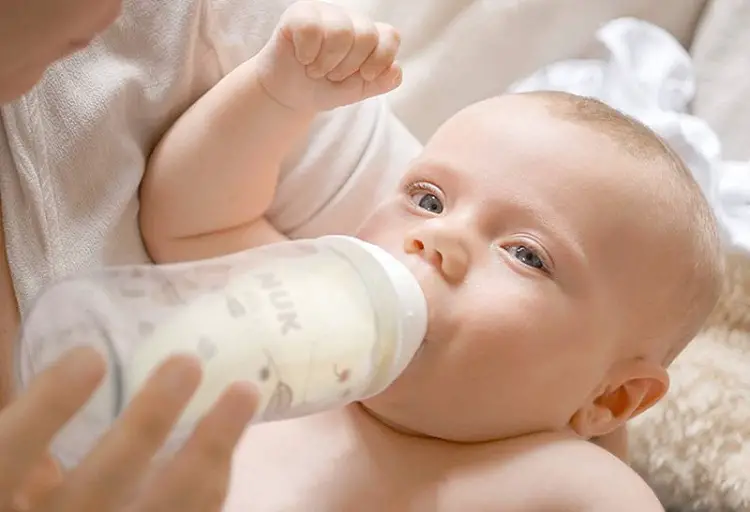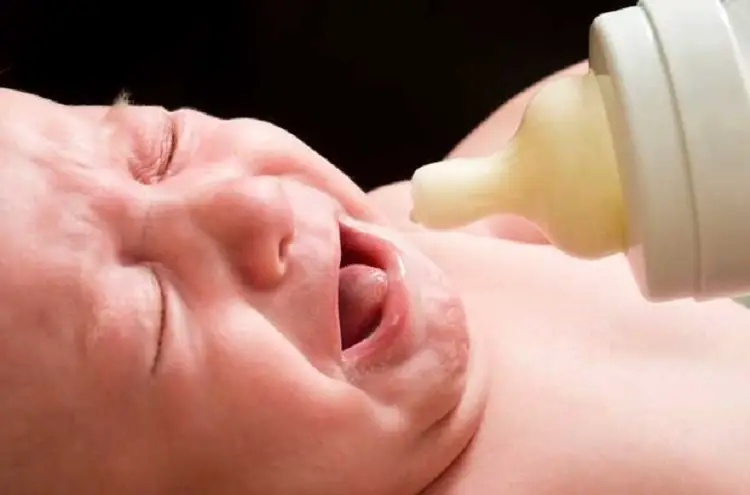As a mother, your milk is the best food for your baby as it contains nutrients needed for your baby’s growth and development. This is why you must know every fact about nursing a baby.
Are you wondering what happens if baby drinks hot formula milk? Your baby wakes you up in the middle of the night crying, you prepare a formula to feed, as soon as his mouth comes in contact with the formula, your baby cries uncontrollably.
You begin to panic. What to do? Worry not! Everything is going to be fine. Read on as we discuss what happens if baby drinks hot formula and bottle feeding mistakes to avoid when feeding your little one.
What Happens If Baby Drinks Hot Formula?
You do not need to warm baby formula before feeding, but some people like to warm their baby’s bottle. If you do decide to warm the bottle, avoid using a microwave.
Microwaves heat milk and food unevenly, which results in “hot spots” which can burn the mucosa of your baby’s mouth and throat.
This can discourage the baby to continue swallowing and of course, the baby will cry uncontrollably.
Other things could make him cry too, check whether there is redness in his mouth. You can offer cool boiled water or breast milk and see how he reacts to it.
Read Also: What Happens If Baby Drinks Spoiled Formula
How To Check The Temperature Of Baby Feeding Bottle
Breastfeeding is quite easy. Breast milk is naturally at the perfect temperature for your baby, and you don’t need to heat or cool it.
When you begin expressing your breast milk, they’re some key things to keep in mind. Once you’ve frozen or chill your breast milk, you’ll need to learn how to check the temperature of your milk, to make sure that it’s not too hot or too cold.
The best way to warm your baby’s bottle is to place the bottle under warm running water, taking care to keep the water from getting into the bottle or on the nipple.
Alternatively, you can sit it in a bowl of warm water until it thaws or comes to a warm temperature. Pour a bit of the baby formula on the inside of your wrist which is the most sensitive part of your arm to make sure it is not too hot.
Simply feeling your baby bottle with your hands is the wrong way to test the temperature of the milk and this leads to giving your baby milk that is overly warm or only warm in patches.
Once you’ve run your baby bottle under warm water or submerged it in a warm bowl, swirl the bottle for it to mix up properly, and then put a few drops on your wrist to know whether it’s too hot, or too cold, or just right.
Do not microwave or boil your baby’s bottle, this could lead to scalding the milk, and damaging the nutrients in the milk, according to Medela stated.
But how do you know the exact temperature your baby’s milk should be? Striking a balance between too hot, warm, and too cold can be sometimes tricky.
Well, Breast milk that is warm but not hot yet (the ideal temperature for babies,) is about 104 degrees stated by Baby Gear Lab. By the time the milk hits 125 degrees, it’s considered hot and the healthy nutrients of the breast milk begin to spoil.
Read Also: 13 Best Formulas That Taste Closest To Breast Milk
10 Bottle-Feeding Mistakes You Should Avoid

Here are 10 bottle feeding mistakes most moms make you should avoid
Mistake #1: Don’t Feed Your Baby Every Time He Cries
Contrary to some ideas, hunger is not the only thing that could make your baby cry. If you just fed and burped your baby 20-30 minutes ago, there is most likely another reason causing the crying.
Check his diaper or take him out from overstimulation like loud sounds, bright lights, and crowds of people. These two are common issues that could make a baby fussy.
Also, check other avenues of comfort before you give your baby a bottle each time he cries. Avoid overfeeding your baby, this can cause some health problems to your baby in the future.
Read Also: What Happens if Baby Drinks Too Much Milk
Mistake #2: Don’t sterilize the bottles
You must sterilize all the bottles, nipples, and feeding supplies thoroughly before the first use. After then, wash with hot, soapy water.
Immediately after each feeding, take your time and thoroughly clean the bottles. An easy way to clean your baby bottle is simply placing the bottles on the top rack of the dishwasher during your next load of dishes.
The high temperature will provide the sterilization required to thoroughly and effectively clean your baby bottle feeding accessories. Remember to place the nipples in a safe area to avoid melting from high temperatures.
Mistake #3: Watering Down Formula To Save Money
A formula can eat deep on your family’s grocery budget, but don’t skimp in the area of your infant’s nutritional needs.
At this important time of baby’s growth, the formula is providing the whole vitamins and minerals your baby needs.
The guideline on the label of the formula you bought should be followed when mixing the formula and water to get the correct proportion of liquid versus powder.
My favorite pick is the NeuroPro from Enfamil. I love this formula simply because it contains Omega 3 DHA, which helps reduce fussiness, crying, and spit-ups in babies within 24 hours. It is also affordable. You can get one here.
Read Also: 12 Best Lactose-Free Formulas
Mistake #4: Heating Formula In The Microwave, For A Quick And Easy Preparation
As a parent, certain things are more important than convenience. Your baby’s health and safety are two of them.
Microwaves have been known to kill important nutrients as well as heat foods to dangerous temperatures.
The microwaving formula in the microwave can make your milk develop “hot spots” that you may not notice when testing the temperature of the milk.
A proper and healthier approach is to slowly heat the milk on the stove in a bowl of hot water. Another effective approach is by using a bottle warmer to heat the bottle.
Mistake #5: To Avoid On-The-Go Convenience, Prepare All Your Bottles Before Your Outings
Of course, it would be great to grab a warm bottle from your diaper bag and feed your baby right away, but a formula that has been prepared is completely unsafe after two hours at room temperature.
Breast milk can be able to stay for a longer time at room temperature, but infant formula can become coagulated and vitamin deficient pretty quickly. If you do want to prepare bottles before stepping out, travel with an ice pack like this one.
This will help keep the prepared formula safe for consumption. It will just need to be heated up safely; babies don’t like cold milk!
Mistake #6: Let The Baby Fall Asleep With A Bottle
Do not let your bottle-fed baby take the bottle to his crib. Juice or milk can damage your baby’s gums and teeth and could cause cavities in early life.
Babies can experience other health hazards from having a bottle in the bed without adult supervision. Be mindful and only allow your baby or infant to drink his bottle with adult supervision.
Read Also: How To Thicken Baby Formula Without Cereals
Mistake #7: Only Burp Baby When It’s Convenient
Even if you’re in a rush to run some errands or do chores like washing the dishes, take time to properly burp your baby.
Trapped gas can be a major discomfort in babies. Also burping your baby insufficiently can lead to spitting up. Try applying for several positions with patience as you wait for your little one to deliver approximately 2-3 burps per feeding.
Mistake #8: Using Plain Tap or Well Water
Although people’s opinions may differ, the safest way with bottle preparation is to use boiled or sterilized drinking water when preparing a bottle.
It is difficult to assess the safety of your tap water in many areas. Rather explore the option of buying previously sterilized water or try sterilizing your own.
Exploring this tip will provide peace of mind about the safety of the water your baby is about to consume.
If you want to sterilize your water at home, simply boil water in a large saucepan for 15 minutes, allow let it cool to room temperature before mixing with the powdered formula.
Mistake #9: Reduce, Reuse Recycle
Does your little one keep leaving a few extra ounces in his bottle after his daily feedings? Don’t try to be eco-friendly and recycle those leftovers.
As you should know, bacteria from your baby’s mouth can enter the milk and sit. This can cause serious health hazards to your baby. Always throw away any prepared leftover formula that has not been consumed in one feeding.
Read Also: Best DHA Supplement For Babies
Mistake #10: You Just Open A Can Of Formula And Begin Scooping!
Don’t ever trust your memory to ensure that the can of formula you bought has not expired. Make sure you always check the expiration date of the formula before preparing your baby’s bottle.
Be aware that canned and liquid formulas can quickly lose their nutritional value. Also always check your formula’s container for dents and budges as they could be harmful to your baby’s health.
We hope this article answers your question “What Happens If Baby Drinks Hot Formula” and also helps bring a little peace of mind when nursing your baby.
If you have any questions or experience with feeding a baby with hot formula, kindly let us know. We would love to hear it
